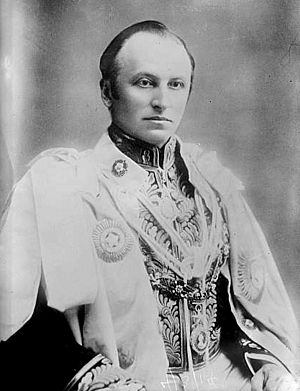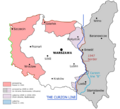George Curzon, 1st Marquess Curzon of Kedleston facts for kids
Quick facts for kids
His Excellency The Most Honourable
The Marquess Curzon of Kedleston
|
|
|---|---|

Lord Curzon, as Viceroy of India
|
|
| Leader of the House of Lords | |
| In office 3 November 1924 – 20 March 1925 |
|
| Monarch | George V |
| Prime Minister | Stanley Baldwin |
| Preceded by | The Viscount Haldane |
| Succeeded by | The Marquess of Salisbury |
| In office 10 December 1916 – 22 January 1924 |
|
| Monarch | George V |
| Prime Minister | |
| Preceded by | The Marquess of Crewe |
| Succeeded by | The Viscount Haldane |
| Secretary of State for Foreign Affairs | |
| In office 23 October 1919 – 22 January 1924 |
|
| Monarch | George V |
| Prime Minister | |
| Preceded by | Arthur Balfour |
| Succeeded by | Ramsay MacDonald |
| Lord President of the Council | |
| In office 3 November 1924 – 20 March 1925 |
|
| Monarch | George V |
| Prime Minister | Stanley Baldwin |
| Preceded by | The Lord Parmoor |
| Succeeded by | The Earl of Balfour |
| In office 10 December 1916 – 23 October 1919 |
|
| Monarch | George V |
| Prime Minister | David Lloyd George |
| Preceded by | The Marquess of Crewe |
| Succeeded by | Arthur Balfour |
| President of the Air Board | |
| In office 15 May 1916 – 3 January 1917 |
|
| Monarch | George V |
| Prime Minister | |
| Preceded by | The Earl of Derby |
| Succeeded by | The Viscount Cowdray |
| Viceroy and Governor-General of India | |
| In office 6 January 1899 – 18 November 1905 |
|
| Monarch | |
| Deputy | The Lord Ampthill |
| Preceded by | The Earl of Elgin |
| Succeeded by | The Earl of Minto |
| Parliamentary Under-Secretary of State for Foreign Affairs | |
| In office 20 June 1895 – 15 October 1898 |
|
| Monarch | Victoria |
| Prime Minister | The Marquess of Salisbury |
| Preceded by | Sir Edward Grey |
| Succeeded by | St John Brodrick |
| Parliamentary Under-Secretary of State for India | |
| In office 9 November 1891 – 11 August 1892 |
|
| Monarch | Victoria |
| Prime Minister | The Marquess of Salisbury |
| Preceded by | Sir John Eldon Gorst |
| Succeeded by | George W. E. Russell |
| Member of the House of Lords Lord Temporal |
|
| In office 21 January 1908 – 20 March 1925 Hereditary Peerage |
|
| Preceded by | The 4th Lord Kilmaine (as Representative peer) |
| Succeeded by | The 2nd Baroness Ravensdale (in Barony) The 2nd Viscount Scarsdale (in Viscountcy) |
| Member of Parliament for Southport |
|
| In office 27 July 1886 – 24 August 1898 |
|
| Preceded by | George Augustus Pilkington |
| Succeeded by | Sir Herbert Naylor-Leyland |
| Personal details | |
| Born |
George Nathaniel Curzon
11 January 1859 Kedleston, Derbyshire, England |
| Died | 20 March 1925 (aged 66) London, England |
| Political party | Conservative |
| Spouses |
Mary Leiter
(m. 1895; died 1906)Grace Duggan
(m. 1917; |
| Children |
|
| Alma mater | Balliol College, Oxford |
George Nathaniel Curzon, 1st Marquess Curzon of Kedleston (11 January 1859 – 20 March 1925) was an important British politician. He was a member of the Conservative Party. He is best known for serving as the Viceroy of India from 1899 to 1905. He also held other major roles, including Leader of the House of Lords and Secretary of State for Foreign Affairs.
Contents
- Early Life and Education
- Early Political Career
- Travels and Writings in Asia
- First Marriage
- Viceroy of India (1899–1905)
- Return to Britain
- In the House of Lords
- First World War
- Second Marriage
- Foreign Secretary (1919–1924)
- Passed Over for Prime Minister
- Death
- Titles and Legacy
- Images for kids
- See Also
Early Life and Education
George Curzon was born in Kedleston, England. He was the eldest son in a large family. His family had lived in Kedleston since the 12th century.
He went to Wixenford School, Eton College, and Balliol College, Oxford. At Oxford, he was very active in political and social clubs. He became the President of the Oxford Union, a famous debating society.
Curzon had a spinal injury when he was young. This caused him pain throughout his life and meant he had to wear a special metal support.
Early Political Career
Curzon began his political career in 1885. He worked for the Marquess of Salisbury, who later became Prime Minister. In 1886, Curzon became a Member of Parliament (MP) for Southport.
He quickly became known for his strong speeches. He served as a junior minister for India and then for Foreign Affairs.
Travels and Writings in Asia
Curzon loved to travel and explore. He journeyed across Russia, Central Asia, Persia (now Iran), Siam (now Thailand), French Indochina, and Korea. These trips helped him learn a lot about Asian countries. He wrote several books about his travels and the politics of these regions.
His journeys also made him think about how important Asia was for British India. He believed that Russia could be a threat to India. He wrote a book called Persia and the Persian Question in 1892. In this book, he showed how important Persia was for Britain's defenses in India.
First Marriage
In 1895, George Curzon married Mary Victoria Leiter. She was the daughter of a wealthy American businessman. Their marriage was happy.
Mary became ill and sadly passed away in 1906 at the age of 36. This was a very difficult time for Curzon. He designed a beautiful chapel at Kedleston church as a memorial to her.
They had three daughters:
- Mary Irene
- Cynthia
- Alexandra Naldera
Viceroy of India (1899–1905)
In 1899, Curzon was appointed Viceroy of India. This was a very powerful role, like being the ruler of India for the British Empire. He was given the title of Baron Curzon of Kedleston.
As Viceroy, he focused on many important areas:
- Frontier Security: He created the North West Frontier Province to better control the border tribes.
- Protecting Indians: He was very strict about British people treating Indians badly. He made sure that Europeans who harmed Indians were punished severely.
- Preserving History: Curzon cared deeply about India's history and culture. He started the restoration of the Taj Mahal and other historical sites.
- Reforms: He set up commissions to improve education, irrigation (water supply for farming), and the police force.
- Partition of Bengal: In 1905, he divided the large province of Bengal into two parts. This was a controversial decision.
Curzon also had disagreements with the head of the Indian Army, Lord Kitchener. These disagreements eventually led to Curzon resigning from his post in 1905.
Return to Britain
After returning to Britain, Curzon faced a difficult time. His wife Mary died in 1906, which was a great personal loss.
In 1907, he became the Chancellor of Oxford University. He worked hard to reform the university.
In the House of Lords
In 1908, Curzon became a member of the House of Lords. This meant he would not return to the House of Commons.
He was very active in the House of Lords. In 1911, he received new titles: Baron Ravensdale, Viscount Scarsdale, and Earl Curzon of Kedleston.
Curzon was also passionate about protecting historical buildings. He helped save Tattershall Castle, Lincolnshire and supported laws to protect ancient monuments.
First World War
During the First World War, Curzon joined the government. He became Lord Privy Seal in 1915. From 1916, he was a key member of Prime Minister David Lloyd George's small War Cabinet. He helped make important decisions about the war.
Second Marriage
In 1917, Curzon married Grace Elvina Hinds. She was a wealthy American widow. They did not have children together, which was a source of sadness for them.
Curzon bought Bodiam Castle in East Sussex, a very old castle that was in ruins. He spent a lot of money restoring it. Later, he gave it to the National Trust so it could be preserved for everyone.
Foreign Secretary (1919–1924)
In 1919, Curzon became the Secretary of State for Foreign Affairs, also known as the Foreign Secretary. This meant he was in charge of Britain's relationships with other countries.
He played a big role in shaping the world after the First World War.
- Curzon Line: He proposed a border between Poland and the Soviet Union, known as the Curzon Line. This line is still close to the border between Poland and its eastern neighbors today.
- Middle East: He worked on problems in the Middle East, helping to create new countries after the fall of the Ottoman Empire. He was involved in the Treaty of Sèvres and the Treaty of Lausanne, which set new borders for Turkey. He also helped with the independence of Egypt and the division of Mandatory Palestine.
Curzon often had disagreements with Prime Minister Lloyd George. However, Lloyd George valued Curzon's deep knowledge of foreign affairs.
Passed Over for Prime Minister
In 1923, the Prime Minister, Bonar Law, retired. Curzon hoped to become the new Prime Minister. However, Stanley Baldwin was chosen instead.
One reason for this was that Curzon was a member of the House of Lords. At that time, it was becoming more common for the Prime Minister to be in the House of Commons. This was because the Commons was elected by the people. Curzon was very disappointed by this decision.
He continued to serve as Foreign Secretary under Baldwin until 1924. Later, he became Lord President of the Council in Baldwin's new government.
Death
George Curzon died in London on 20 March 1925, at the age of 66. He was buried next to his first wife, Mary, in Kedleston.
His titles of Baron, Earl, and Marquess of Curzon of Kedleston ended when he died because he had no sons. However, some of his other titles were passed down to his daughters and nephews.
Titles and Legacy
Curzon held many important titles throughout his life. He was created a Baron, Viscount, Earl, and finally a Marquess.
He is remembered as a dedicated public servant who worked tirelessly for the British Empire. He was known for his intelligence, hard work, and strong opinions.
Several places in India are named after him, including Curzon Hall at the University of Dhaka and Curzon Gate in Burdwan.
Images for kids
-
Curzon was educated at Balliol College, Oxford and was later a Prize Fellow of All Souls College, Oxford
-
Curzon—procession to Sanchi Tope, 28 November 1899.
-
Lord Curzon of Kedleston by John Singer Sargent, 1914. Royal Geographical Society
-
The territorial changes of Poland. Light blue line: Curzon Line "B" as proposed by Lord Curzon in 1919. Dark blue line: "Curzon" Line "A" as proposed by the Soviet Union in 1940. Pink: Formerly German provinces annexed by Poland after World War II. Grey: Pre–World War II Polish territory east of the Curzon Line annexed by the Soviet Union after the war.
See Also
 In Spanish: George Curzon para niños
In Spanish: George Curzon para niños














